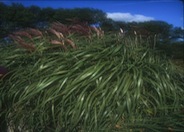
Common name:Munstead Dwarf Lavender
Botanical name:Lavandula angustifolia 'Munstead'
While this hybrid is half the size of the standard angustifolia, it flowers early and has a more intense flower color than most of the species. Its foliage and flowers are good for sachets. This is a perfect choice for smaller scale situations. It is drought tolerant and attracts butterflies and hummingbirds.
-Cornflower Farms

Common name:Olive
Botanical name:Olea europaea
This broad tree will grow to 40' tall and has small, gray/green leaves with fleshy black fruit that appears in fall.

Common name:Eulalia Grass
Botanical name:Miscanthus sinensis 'Flamingo'
These deciduous grasses grow from 4-7' tall, and often turn orange or dark red before going dormant. Tall, showy spikes of feathery, curved seed heads are borne and retained well into the winter or the following spring. It should receive sun to part
shade, and average to little summer watering. -Monterey Bay Nursery

Common name:Rosemary
Botanical name:Rosmarinus officinalis
Rosemary is hardy in full sun areas where winter temperatures do not drop below 10 degrees F. They can be grown in a clay pot with well-drained, porous soil in bright indoor light, and will also flourish on the backporch in spring, summer and fall.
Its beautiful, slowly trailing stems and shiny slender leaves are perfect for showing off the small light blue flowers that blossom in the summer.
More than half of the water used at your home is for outside purposes. Studies show that on average, half of the water used outdoors is wasted. The leading cause of waste is incorrectly set and poorly managed irrigation controllers. The second biggest cause of wastage is broken irrigation equipment that goes undetected. There are a few basic things you can do to make a big difference in your water use.
Click in the green box for more information
Designer:
Photographer: GardenSoft
Incorporate compost 6" into your soil to retain water, reduce compaction, feed earthworms, and provide valuable nutrients to your plants.
Remove irrigation water and fertilizer from areas where you don't want weeds to grow.